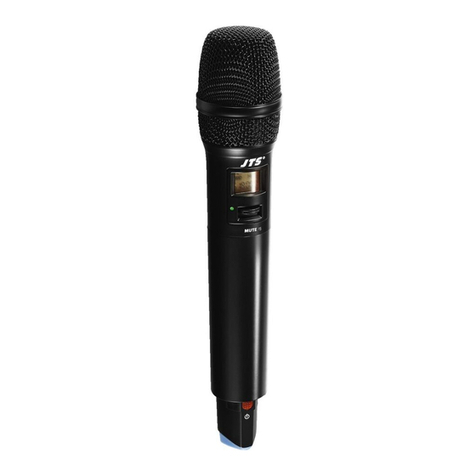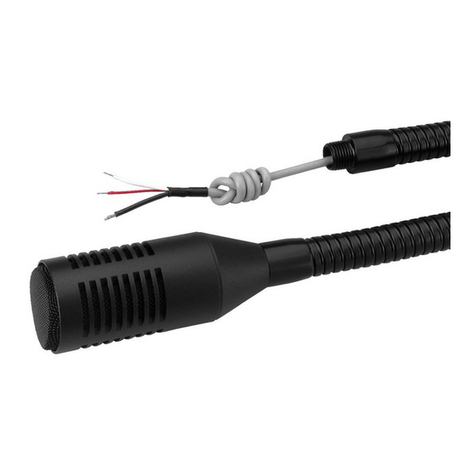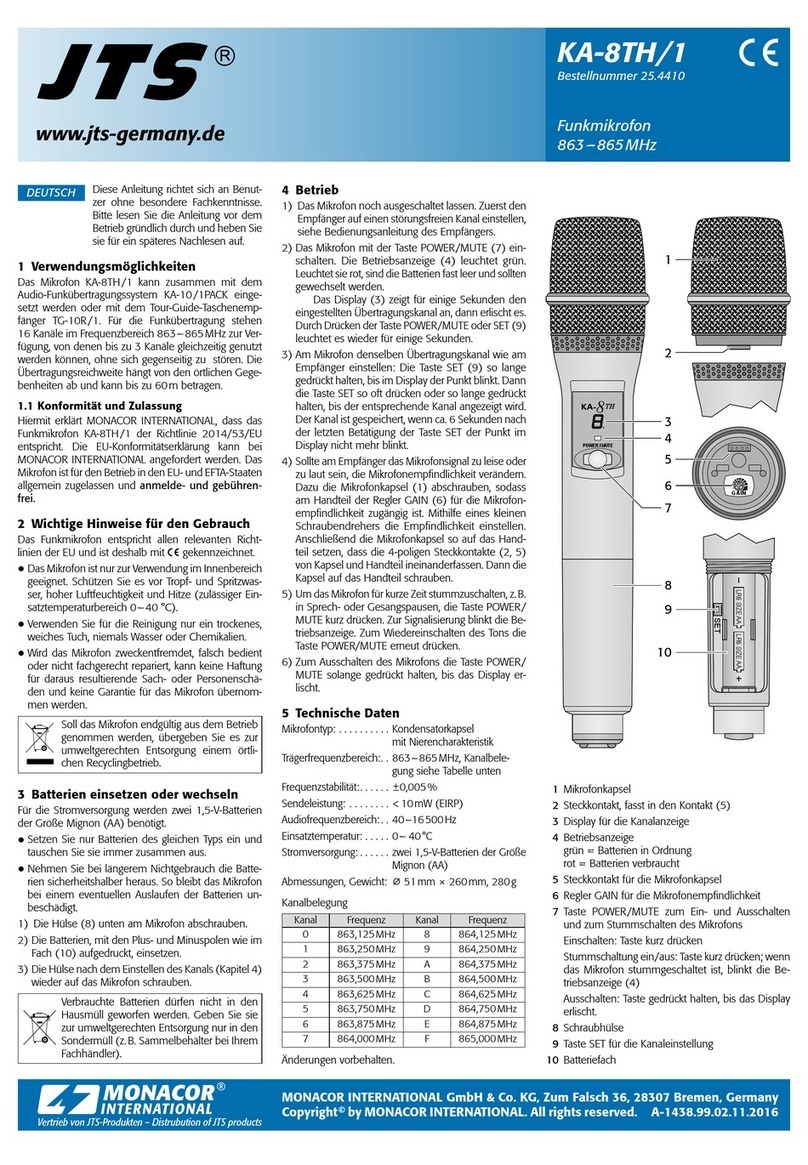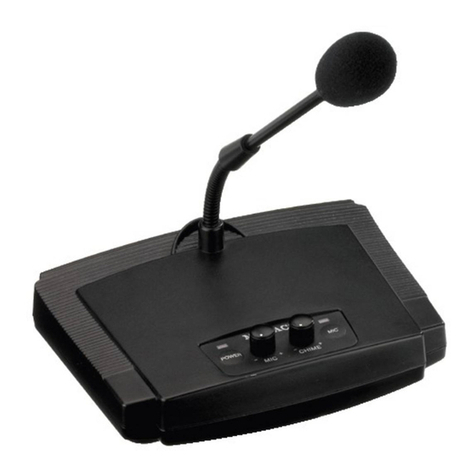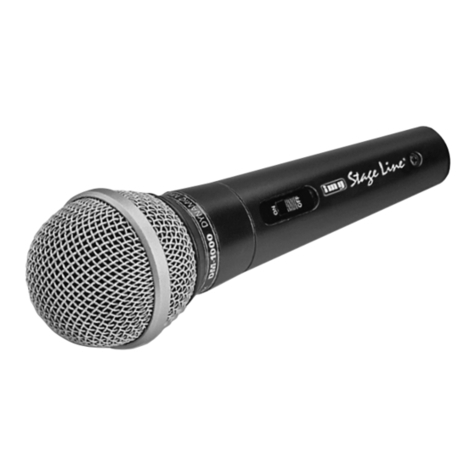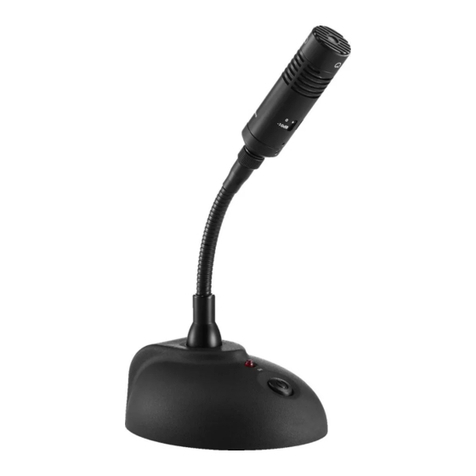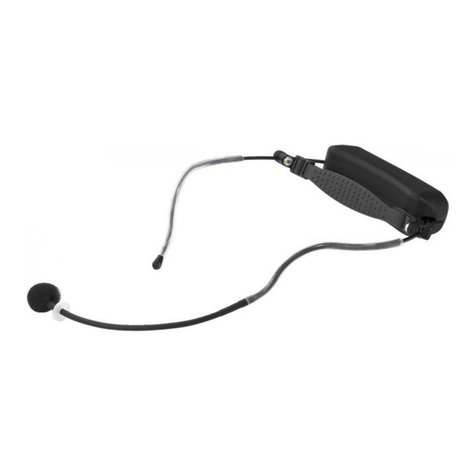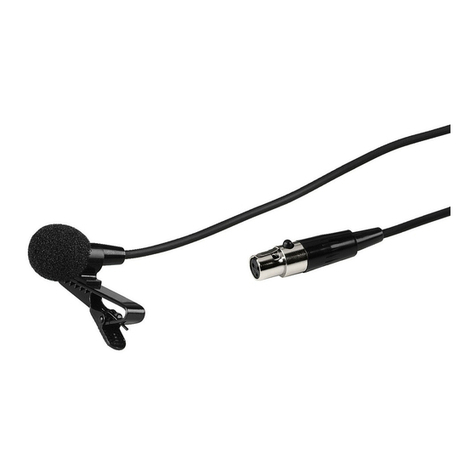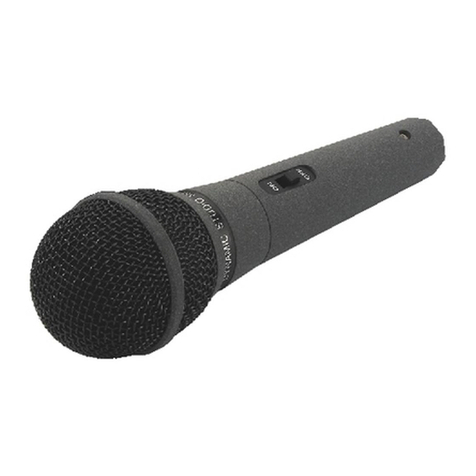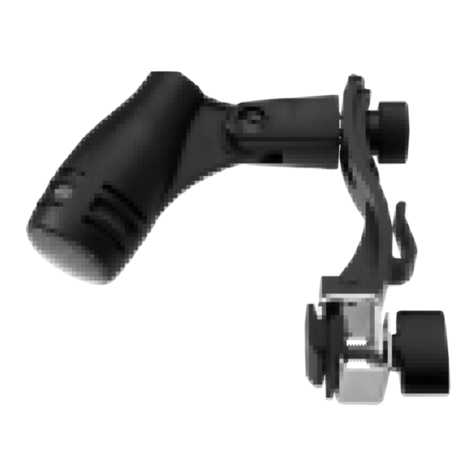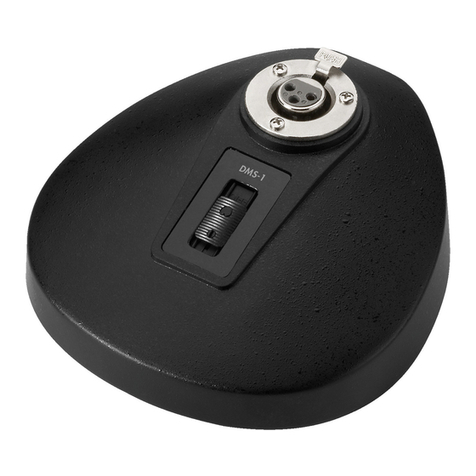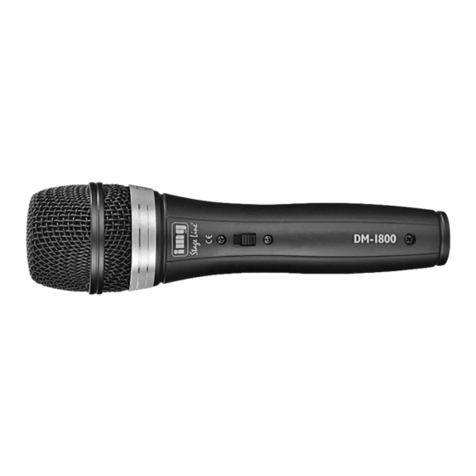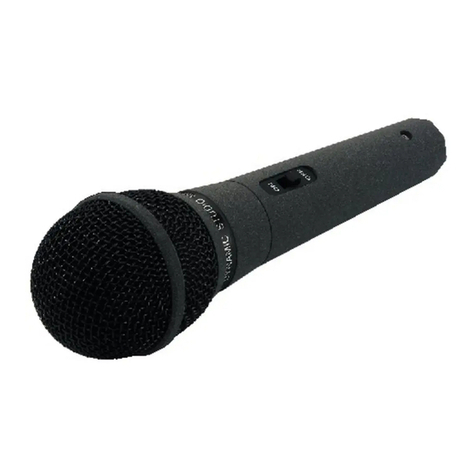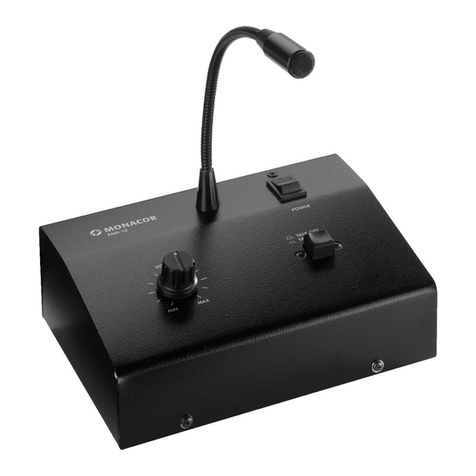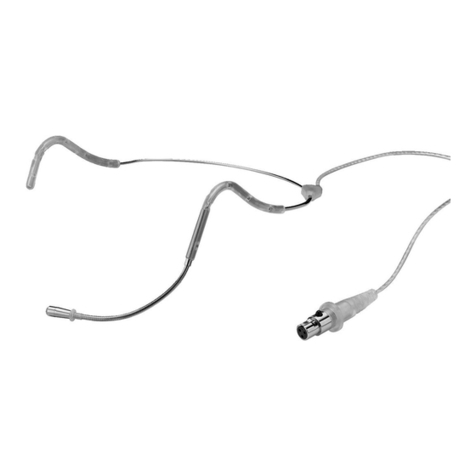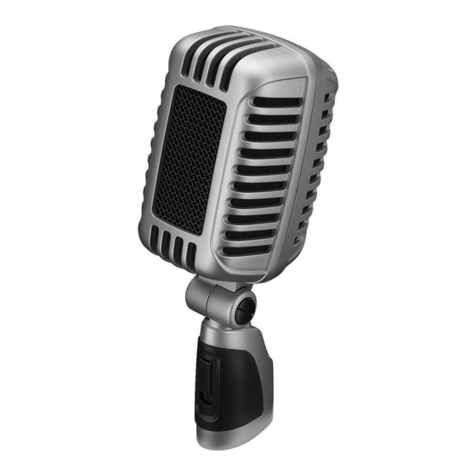Microphone électret
directionnel
Veuillez lire la présente notice avec attention avant
le fonctionnement et conservez-la pour pouvoir vous
y reporter ultérieurement.
Possibilités dʼutilisation
Le microphone électret directionnel ECM-950 avec
caractéristique commutable (cardioïde/supercar-
dioïde) est spécialement conçu pour des enregis-
trements nécessitant une directivité importante à
cause du bruit ambiant perturbateur, par exemple
en cas dʼenregistrements en extérieur pour des réa-
lisations de films ou de vidéos. Le micro est livré
avec un coffret de transport plastique, un support
micro, une bonnette de protection anti-vent et deux
cordons de liaison.
Conseils dʼutilisation importants
Le microphone répond à toutes les directives né-
cessaires de lʼUnion Européenne et porte donc le
symbole .
GProtégez le micro de lʼhumidité et de la chaleur
(plage de température de fonctionnement autori-
sée 0 – 40 °C). Le micro nʼest pas protégé contre
les intempéries. En cas dʼenregistrements en
extérieur, veillez à le protéger de la pluie ou au-
tres précipitations.
GPour le nettoyer, utilisez un chiffon sec et doux,
en aucun cas de produits chimiques ou dʼeau.
GNous déclinons toute responsabilité en cas de
dommages matériels ou corporels si le micro est
utilisé dans un but autre que celui pour lequel il a
été conçu, sʼil nʼest pas correctement branché ou
sʼil nʼest pas réparé par une personne habilitée ;
en outre, la garantie deviendrait caduque.
Fonctionnement
1) Dévissez à lʼextrémité inférieure du micro le ca-
pot à vis et insérez 1 batterie 1,5 V (type R6) selon
les inscriptions dans le compartiment batterie.
En cas de non-utilisation prolongée (p. ex.
supérieure à une semaine), retirez la batterie,
elle pourrait couler et endommager le micro.
2) Le support micro peut se fixer via un filetage
6,35 (1/4″), par exemple directement sur un
caméscope. En revanche si le micro doit être
vissé sur un pied avec un filetage 16 mm (5/8″),
dévissez lʼadaptateur fileté situé sur le support
micro. Placez le micro sur le support. Si besoin,
placez la bonnette de protection.
3) Connectez le micro via sa prise jack 3,5 à lʼappa-
reil suivant, soit avec le cordon spiralé de 50 cm
Lorsque le microphone est définitivement
retiré du service, vous devez le déposer
dans une usine de recyclage adaptée pour
contribuer à son élimination non polluante.
Ne jetez pas les batteries usagées dans la pou-
belle domestique ; apportez-les à votre revendeur
ou déposez-les dans un lieu de recyclage adapté.
(p. ex. à un caméscope) soit avec le cordon 7,5 m
(p. ex. à un magnétophone). Reliez toujours lʼex-
trémité du cordon avec le loquet de verrouillage
dans la prise sur le micro et vissez pour éviter que
la prise ne se défasse pendant le fonctionnement.
4) Avec lʼinterrupteur à glissière sur le micro, choi-
sissez la directivité :
NORMAL = cardioïde, TELE = supercardioïde
Le micro est ainsi allumé.
5) Pour éteindre le micro, mettez lʼinterrupteur sur la
position inférieure OFF.
Caractéristiques techniques
Type : . . . . . . . . . . . . . . . . cardioïde/
supercardioïde
Bande passante : . . . . . . . 50 – 16 000 Hz
Sensibilité, impédance
NORMAL (cardioïde) : . 3 mV/Pa à 1 kHz, 1 kΩ
TELE (supercardioïde) : 22 mV/Pa à 1 kHz,
2,3 kΩ
Pression sonore max. : . . 115 dB
Rapport signal sur bruit : . 60 dB
Alimentation : . . . . . . . . . . batterie 1,5 V de type
R6 (non livrée)
Temp. de fonctionnement: 0 – 40 °C
Dimensions : . . . . . . . . . . ∅22 mm × 280 mm
Poids : . . . . . . . . . . . . . . . 350 g
Branchement micro : . . . . jack 3,5 mono
Tout droit de modification réservé.
Microfono direzionale
allʼelettrete
Vi preghiamo di leggere attentamente le presenti
istruzioni prima della messa in funzione e di con-
servarle per un uso futuro.
Possibilità dʼimpiego
Il microfono allʼelettrete ECM-950 con possibilità
di selezionare la caratteristica direzionale (a car-
dioide/a super cardioide) è particolarmente indicato
per registrazioni che richiedono un forte effetto dire-
zionale a causa dei rumori di sottofondo, p. es. nelle
riprese allʼaperto per video e cinema. Sono in dota-
zione una custodia di plastica, un supporto per il
microfono, una spugna antivento nonché due cavi
di collegamento.
Avvertenze importanti per lʼuso
Il microfono è conforme a tutte le direttive rilevanti
dellʼUE e pertanto porta la sigla .
GProteggere il microfono dallʼumidità e dal calore
(temperatura dʼimpiego ammessa fra 0 e 40 °C).
Il microfono non è resistente alle intemperie. Nel
caso di riprese allʼesterno proteggerlo dalla piog-
gia e da altre precipitazioni.
GPer la pulizia usare solo un panno morbido,
asciutto; non impiegare in nessun caso prodotti
chimici o acqua.
GNel caso dʼuso improprio, di collegamenti sba-
gliati o di riparazione scorretta non si assume
nessuna responsabilità per eventuali danni con-
sequenziale a persone o a cose e cessa ogni
diritto di garanzia per il microfono.
Messa in funzione
1) Svitare la boccola dalla parte inferiore del mi-
crofono. Inserire una batteria 1,5 V mignon (AA)
come segnato sul vano batteria.
Nel caso di non utilizzo prolungato (p. es. più
di una settimana), conviene togliere la batteria
per evitare che perda danneggiando il microfono.
2) Per mezzo della filettatura 6,35 mm (1/4″), il sup-
porto del microfono può essere fissato p. es. di-
rettamente sul camcorder. Se il microfono deve
essere montato su uno stativo con filettatura
16 mm (5/8″) occorre svitare lʼadattatore dal sup-
porto. Inserire il microfono sul supporto. Se
necessario applicare la spugna antivento.
3) Collegare il microfono con lʼapparecchio a valle,
o con il cavo spiralato di 50 cm (p. es. nel caso di
un camcorder) o con il cavo di 7,5 m (p. es. nel
caso di un registratore audio). Inserire sempre il
terminale del cavo con la filettatura nella presa
Se si desidera eliminare il microfono defini-
tivamente, consegnarlo per lo smaltimento
ad unʼistituzione locale per il riciclaggio.
Non gettare le batterie scariche nei rifiuti di casa
bensì negli appositi raccoglitori.
del microfono ed avvitarlo per escludere che il
connettore si stacchi durante lʼuso.
4) Selezionare la caratteristica direzionale con lʼap-
posito commutatore:
NORMAL = cardioide, TELE = super cardioide.
Il microfono è così acceso.
5) Per spegnere il microfono, spostare il commuta-
tore nella posizione inferiore OFF.
Dati tecnici
Sistema: . . . . . . . . . . . . . . cardioide/
super cardioide
Banda passante: . . . . . . . 50 – 16 000 Hz
Sensibilità, impedenza
Normal (cardioide): . . . . 3 mV/Pa a 1 kHz, 1 kΩ
Tele (super cardioide): . 22 mV/Pa a 1 kHz,
2,3 kΩ
Pressione sonora max.: . . 115 dB
Rapporto S/R: . . . . . . . . . 60 dB
Alimentazione: . . . . . . . . . batteria 1,5 V, mignon
(AA) [non in dotazione]
Temperatura dʼesercizio: . 0 – 40 °C
Dimensioni: . . . . . . . . . . . ∅22 mm × 280 mm
Peso: . . . . . . . . . . . . . . . . 350 g
Collegamento microfono: . jack 3,5 mm, mono
Con riserva di modifiche tecniche.
ECM-950
Best.-Nr. 23.3280
wwwwww..iimmggssttaaggeelliinnee..ccoomm
Réponse en fréquence
Risposta di frequenza
Caractéristique
Caratteristica direzionale
NORMAL TELE
NORMAL TELE
®
MONACOR INTERNATIONAL GmbH & Co. KG
•
Zum Falsch 36
•
28307 Bremen
•
Germany
Copyright
©
by MONACOR INTERNATIONAL. All rights reserved. A-0132.99.02.09.2011
I
F B CH
